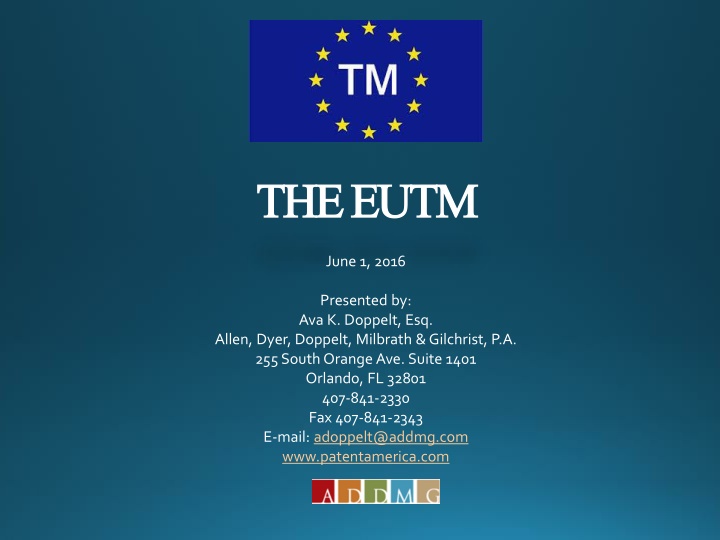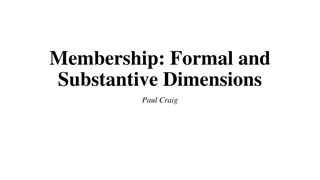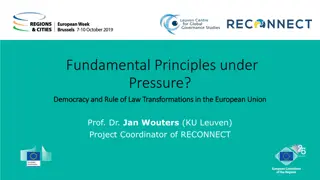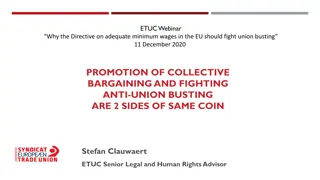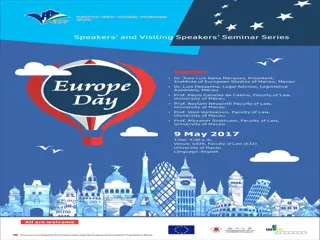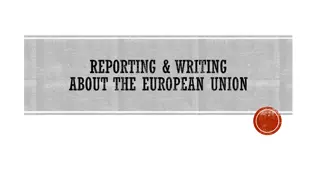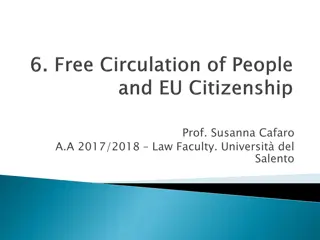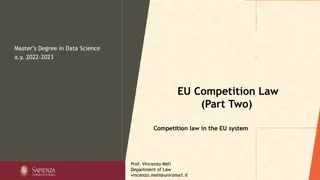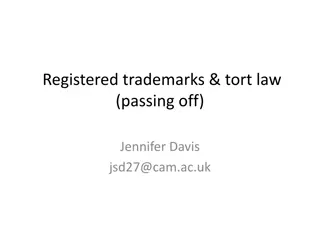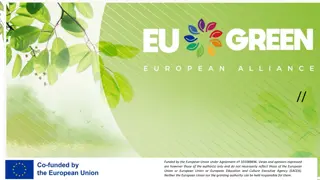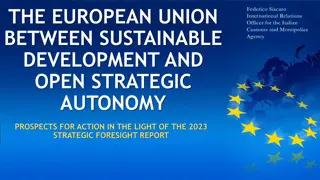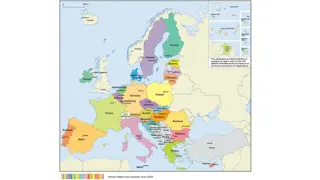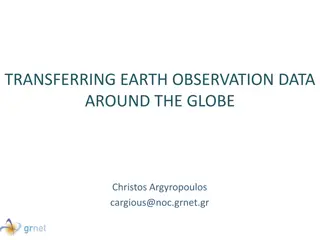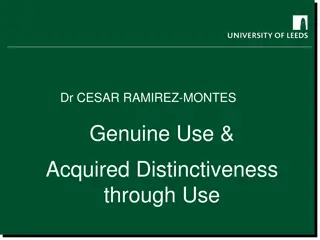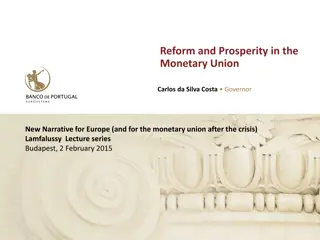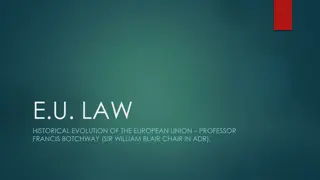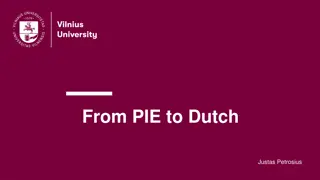The Evolution of European Union Trademarks: A Journey Through History
Exploring the transformation of European Union Trademarks (EUTM) from their inception to the present day, this narrative delves into the political and economic foundations of the European Union. From the establishment of the European Economic Community in 1958 to the development of a single market and the introduction of the EU as we know it today, discover the key milestones that have shaped the region's intellectual property landscape.
Download Presentation

Please find below an Image/Link to download the presentation.
The content on the website is provided AS IS for your information and personal use only. It may not be sold, licensed, or shared on other websites without obtaining consent from the author.If you encounter any issues during the download, it is possible that the publisher has removed the file from their server.
You are allowed to download the files provided on this website for personal or commercial use, subject to the condition that they are used lawfully. All files are the property of their respective owners.
The content on the website is provided AS IS for your information and personal use only. It may not be sold, licensed, or shared on other websites without obtaining consent from the author.
E N D
Presentation Transcript
THE EUTM THE EUTM June 1, 2016 Presented by: Ava K. Doppelt, Esq. Allen, Dyer, Doppelt, Milbrath & Gilchrist, P.A. 255 South Orange Ave. Suite 1401 Orlando, FL 32801 407-841-2330 Fax 407-841-2343 E-mail: adoppelt@addmg.com www.patentamerica.com
-YOU TEM? YOU TEM? EWW TEM? E U T M? 2
EUTM The new European Union Trademark f/k/a CTM, The Community Trademark ( The new Istanbul, not Constantinople ) 3
And its administered by the EUIPO ( YOU PO? YOU- PO? E U P O?), The European Union Intellectual Property Office, which used to be the OHIM ( -HIM), The Office for Harmonization in the Internal Market 4
BACKGROUND European Union United in Diversity A unique economic and political union among 28 European countries to foster economic cooperation and avoid conflict. 6
Formed in 1958 as the European Economic Community (EEC) (The Treaty of Rome) Started with 6 countries Belgium Frace W. Germany Netherlands Italy Luxembourg 7
Since then, a huge single market has developed. It began purely as an economic union but now spans policy areas, from climate, environment and health, to external relations and security, justice and immigration. A name change in 1993 to the European Union (EU) reflected this. The Maastricht Treaty established the EU name and introduced European citizenship. 8
Everything is founded on treaties agreed to voluntarily by the member countries. It is governed by the principle of representative democracy. Citizens are represented at the union level in the European Parliament. Member states are represented in the European Council of the EU. 9
Helped raise European living standards Launched a single European currency the Euro (19 States) Because of the abolition of border controls among EU countries, people can travel freely throughout most of the continent. EU received the Nobel Peace Prize in 2012 for advancing the cause of peace, reconciliation, democracy and human right in Europe. The single or internal market is the EU s main economic engine, enabling most goods, services, money and people to move freely. 10
Another objective is to develop this huge resource in other areas like energy, knowledge and capital markets to ensure that Europeans can draw maximum benefit from it. Its GDP in 2014 was $18,495 trillion U.S. dollars, 24% of the global GDP. The EU anthem is based on Beethoven s Ninth Symphony. 11
As of today, there are 28 member states (includes over 508 million inhabitants, comprising 7.3% of the world s population, and covers 1,7047,787 square miles). . Austria 1995 Belgium 1958 Denmark 1973 Estonia 2004 Bulgaria 2007 Finland 1995 Croatia 2013 France 1958 Cyprus 2004 Germany 1958 *Continued On Next Page* Czech Republic 2004 Greece 1981 12
Hungary 2004 Poland 2004 Ireland 1973 Portugal 1986 Italy 1958 Romania 2007 Latvia 2004 Slovakia 2004 Lithuania 2004 Slovenia 2004 Luxembourg 1958 Spain 1986 Malta 2004 Sweden 1995 Netherlands 1958 United Kingdom 1973 13
Later this month, on June 23, well see if the UK decides to leave ( Brexit ) or stay. 14
HISTORY OF THE CTM/ EUTM The European Trademark System is a dual system, made up of the EU- wide trademark system and the national systems of the EU member states. The EU trademark concept originated in 1964 in a draft of a Convention of European Trademark Law. 1980 The first proposal for a regulation dealing with the European trademark appeared. The regulation establishing the trademark office was adopted by the council of the European Union in 1993. Revised in 2009 and 2015. It created the EUTM (CTM) as a legal instrument in the EU law and established the office as an EU agency with legal, administrative and financial autonomy. April 1, 1996 The first EU trademark applications were processed and the register started. 15
TOP 10 COUNTRIES THAT APPLY FOR EUTMs Germany U.S. U.K. Italy Spain France Netherlands Switzerland Japan Austria 16
Since the creation of the EUTM (CTM), The office has received over 1,500,000TM applications, originating in more than 200 countries. In 2015, 130,375 applications were received, an 11% increase over 2014. 17
EUIPO AVENIDA de EUROPA, 4 E-03008 ALICANTE, SPAIN INFO: +34 965 139 100 Approximately 800 professional employees Largest agency in EU 5 working languages: English, French, German, Italian and Spanish Process TM applications in the 23 official languages of the EU Since 2003, also manages EU design registrations 18
Promotes cooperation with IP and industrial property offices in the member states and throughout the world Executive Director is Antonio Campinos, a Portuguese national, since 2010 Finances all its operations through registration fees without any burden on the EU or its taxpayers 19
SEARCH TOOLS TM VIEW Most complete search tool of its kind. Connected to databases of 40+ IP offices, including those of all EU member states, U.S., Korea, Mexico and Canada. Contains about 32 million registered trademarks. Since 2010, it s received more than 16 million searches from 149 countries. DESIGN VIEW Most complete design search. Contains about 8.9 million registered designs. 20
The most recent changes to the trademark law in the EU (what we re talking about today) went into effect on March 23, 2016 Member states have until January 15, 2019to implement any necessary changes into their laws, and up to January 15, 2023to introduce administrative cancellation proceedings. 21
WHAT IS AN EUTM? A trademark which is pending registration or is registered in the European Union as a whole, rather than on a national level within the individual countries in the EU. The EU TM system creates a unified TM registration system in Europe, whereby one EU registration provides protection in all member states of the EU. The system is unitary An objection against an EU application in any member state can defeat the entire application. An EUTM registration is enforceable in all member states.
CHARACTER AND ADVANTAGES Gives its owner a uniform right applicable in all member states of the EU by a single procedure which simplifies TM policies at the European level. It fulfills the three essential functions of a TM at the European level: (1) Identifies the origin of goods and services (2) Guarantees consistent quality (3) Is a form of communication, a basis for publicity and advertising 23
Can be a manufactures mark, a mark for goods of a trading company, a service mark, or a collective mark. And now also a certification mark. Trademark rights are obtained by registration in the EUIPO. When registered, transferred or allowed to lapse, the effect is EU-wide. Valid 10 years, and can be renewed indefinitely. 24
FEES The initial cost of filing, though generally higher than the filing fees in the individual countries, is much less than the cost of filing separate national applications in all 28 member states. The applicant for a failed EU TM application can convert the application into one or more applications in EU states in which the grounds for refusal do not apply (but can t recover the EU filing fees and must pay fees in each country where the EU application is converted). 25
What changed on March 23, 2016? 26
NAMES Community Trademark (CTM) Trademark (EUTM) European Union Includes all previously registered CTMs, which became EUTMs. OHIM (EUIPO) European Union Intellectual Property Office 27
FEES No more three classes for the price of one Application fees will be charged (as in the U.S.) on a per-class basis, rather than prior system where the basic fee covered up to three classes, which resulted in applicants filing in more classes than needed 28
OLD APPLICATION FEES NEW APPLICATION FEES (FOR FILING ONLINE) 1 3 CLASSES 900 SINGLE-CLASS APPLICATION 850 TWO-CLASS APPLICATION 900 EACH ADDITIONAL CLASS 150 PER CLASS (Means slight savings for those filing single-class applications, no change for two classes, and increase for three or more classes) 29
RENEWAL Significant reduction in renewal fees by up to 37%. They mirror application fees ( 850for single class, 900for two classes, 150 for each additional class) Means a savings of 500 for renewals in one class, and of 250 per class for each class above three. Payment of application and renewal fees is now due on filing (no longer one-month grace period). 30
APPLICATION FORMALITIES PRIORITY Must claim priority at time of filing. No longer have further two months to do so. Documents needed to support a priority claim must be filed within three months of date of filing application. 31
SEARCHES Old system whereby OHIM automatically provided applicants with results of search of CTM register replaced by opt-in system for both search of EUTM register and of national registers that offer such reports. No fees for EUTM search report, but fees remain for national search reports. (Europeans say they are not doing these searches.) Regardless of whether applicant requested search of EUTM register, EUIPO will send citation letters to owners of any earlier EUTMs cited, unless they request not to receive such notification. No longer one-month hiatus between transmission of search report to applicant and publication of application, so applications should be published and registered more quickly. 32
GRAPHIC REPRESENTATION Mark applied for no longer required to be capable of graphic representation, so opens door to non- traditional marks such as sounds, smells, tastes. But extends existing ground for refusal of shapes (functionality). 33
CLASS HEADINGS Endorsement of literal meaning approach to class headings. Per IP Translator case, goods and services identifications that include class headings are deemed to cover the literal meaning of the terms covered, nothing more, i.e., not all goods or services within the class. Note: Owners of registrations filed before June 22, 2012 with class heading coverage have until September 23, 2016 to file a declaration saying their intention at time of filing was to obtain protection beyond literal meaning of class heading and specify the specific goods and services (if in NICE classification list at time of filing date). 34
OPPOSITIONS Opposition period will still last three months but will start one month after publication by EUIPO, rather than the former six months. Will now be able to oppose EUTM applications on basis of protected designations of origin or geographic indications. Oppositions can be based on a reputation claim, regardless of whether the goods and services of the opposed application are similar or dissimilar to those of opposer. Where opposition is based on a prior EU registration, the proof of use date is now the filing date of the opposed application, rather than its date of publication. 35
HARMONIZATION AT MEMBER STATE LEVEL Proceedings for opposition, revocation and invalidity must be a jointly requested suspension period of at least two months. Malta, Benelux, France, Spain and Italy will have to change practice. Mandatory bad faith grounds for cancellation. Mandatory provision for reputation-based refusal. Lithuania and Cyprus must change. Mandatory six-month grace period for late renewals. Requires member states to make available office-based cancellation actions (7-Year phase-in). Established formal framework of cooperation between EUIPO and national marks. 36
SEIZURE OF COUNTERFEIT GOODS Allows TM owners to seize counterfeit goods in customs situations in the EU under defined circumstances. FAIR USE Use of one s personal name is a defense to an infringement claim, but not if it s a corporate name (e.g. Marriott, Disney). Generic and merely descriptive terms may be used in their descriptive sense ( Regular fair use). Referential use one can use a mark to identify or refer to the goods or services of the proprietor of the TM ( Nominative fair use). CERTIFICATION MARKS In 2017 can register EU-wide certification marks. Must file the rules governing use within two months of filing. 37
The End 38
